NCERT Exemplars: Electrostatic Potential & Capacitance | NCERT Exemplar & Revision Notes for NEET PDF Download
MULTIPLE CHOICE QUESTIONS - I
Q.1. A capacitor of 4 µ F is connected as shown in the circuit (Fig. 2.1). The internal resistance of the battery is 0.5Ω . The amount of charge on the capacitor plates will be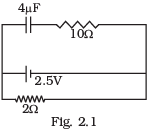 (a) 0
(a) 0
(b) 4µ C
(c) 16µ C
(d) 8µ C
Ans. (d)
Solution.
Key concept: A capacitor offers zero resistance in a circuit when it is uncharged, i.e., it can be assumed as short circuited and it offers infinite resistance when it is fully charged.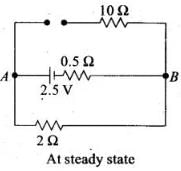 At steady state the capacitor offers infinite resistance in DC circuit and acts as open circuit as shown in figure, therefore no current flows through the capacitor and 10 Ω resistance, leaving zero potential difference across 10 Ω resistance. Hence potential difference across capacitor will be the potential difference across A and B.
At steady state the capacitor offers infinite resistance in DC circuit and acts as open circuit as shown in figure, therefore no current flows through the capacitor and 10 Ω resistance, leaving zero potential difference across 10 Ω resistance. Hence potential difference across capacitor will be the potential difference across A and B.
The potential difference across lower and middle branch of circuit is equal to the potential difference across capacitor of upper branch of circuit.
Current flows through 2 Ω resistance from left to right, is given by I=v/R+r=1A. The potential difference across 2Ω resistance, V=IR= 1 x 2 = 2V Hence potential difference across capacitor is also 2 V.
The charge on capacitor is q = CV= (2 μF) x 2 V = 8 μC.
Q.2. A positively charged particle is released from rest in an uniform electric field. The electric potential energy of the charge
(a) Remains a constant because the electric field is uniform.
(b) Increases because the charge moves along the electric field.
(c) Decreases because the charge moves along the electric field.
(d) Decreases because the charge moves opposite to the electric field.
Ans. (c)
Solution.
Key concept: Electric potential decreases in the direction of electric field. The direction of electric field is always perpendicular to one equipotential surface maintained at high electrostatic potential to other equipotential surface maintained at low electrostatic potential.
The positively charged particle experiences electrostatic force along the direction of electric field, hence moves in the direction of electric field. Thus, positive work is done by the electric field on the charge. We know
Hence electrostatic potential energy of the positive charge decreases.
Q.3. Figure 2.2 shows some equipotential lines distributed in space. A charged object is moved from point A to point B.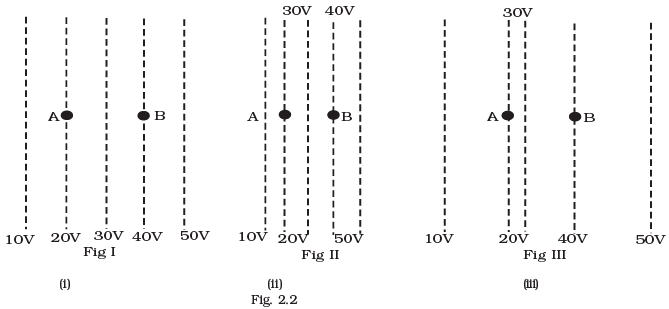 (a) The work done in Fig. (i) is the greatest.
(a) The work done in Fig. (i) is the greatest.
(b) The work done in Fig. (ii) is least.
(c) The work done is the same in Fig. (i), Fig. (ii) and Fig. (iii).
(d) The work done in Fig. (iii) is greater than Fig. (ii)but equal to that in Fig. (i).
Ans. (c)
Solution.
Key concept: For a given charge distribution, locus of all points or regions for which the electric potential has a constant value are called equipotential regions. Such equipotential can be surfaces, volumes or lines. Regarding equipotential surface the following points should be kept in mind:
- The density of the equipotential lines gives an idea about the magnitude of electric field. Higher the density, larger the field strength.
- The direction of electric field is perpendicular to the equipotential surfaces or lines.
- The equipotential surfaces produced by a point charge or a spherically charge distribution are a family of concentric spheres.
- For a uniform electric field, the equipotential surfaces are a family of plane perpendicular to the field lines.
- A metallic surface of any shape is an equipotential surface.
- Equipotential surfaces can never cross each other.
- The work done in moving a charge along an equipotential surface is always zero.
As the direction of electric field is always perpendicular to one equipotential surface maintained at high electrostatic potential than other equipotential surface maintained at low electrostatic potential. Hence direction of electric field is from B to A in all three cases.
The positively charged particle experiences electrostatic force along the direction of electric field, hence moves in the direction opposite to electric field. Thus, the work done by the electric field on the charge will be negative. We know
Here initial and final potentials are same in all three cases and same charge is moved, so work done is same in all three cases.
Q.4. The electrostatic potential on the surface of a charged conducting sphere is 100V. Two statments are made in this regard:
S1 : At any point inside the sphere, electric intensity is zero.
S2 : At any point inside the sphere, the electrostatic potential is 100V.
Which of the following is a correct statement?
(a) S1 is true but S2 is false.
(b) Both S1 & S2 are false.
(c) S1 is true, S2 is also true and S1 is the cause of S2.
(d) S1 is true, S2 is also true but the statements are independant.
Ans. (c)
Solution.
We know, the electric field intensity E and electric potential V are related
E=dV/dr
If electric field intensity E= 0, then dV/dr = 0. It means, E = 0 inside the charged conducting sphere causes uniform potential inside the sphere. Hence uniform electrostatic potential 100 V will be at any point inside the sphere.
Important points:
- The electric field zero does not necessary imply that electric potential is zero. E.g., the electric field intensity at any point inside the charged spherical shell is zero but there may exist non-zero electric potential.
- If two charged particles of same magnitude but opposite sign are placed, the electric potential at the midpoint will be zero but electric field is not equal to zero.
Q.5. Equipotentials at a great distance from a collection of charges whose total sum is not zero are approximately
(a) Spheres
(b) Planes
(c) Paraboloids
(d) Ellipsoids.
Ans. (a)
Solution.
The collection of charges, whose total sum is not zero, with regard to great distance can be considered as a single point charge. The equipotential surfaces due to a point charge are spherical.
Important point:
The electric potential due to point charge q is given by V=q/4πϵ0r
It means electric potential due to point charge is same for all equidistant points. The locus of these equidistant points, which are at same potential, form spherical surface.
Q.6. A parallel plate capacitor is made of two dielectric blocks in series. One of the blocks has thickness d1 and dielectric constant k1 and the other has thickness d2 and dielectric constant k2 as shown in Fig. 2.3. This arrangement can be thought as a dielectric slab of thickness d (= d1+d2) and effective dielectric constant k. The k is
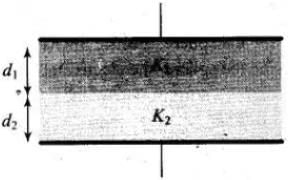 (a)
(a) 
(b) 
(c) 
(d) 
Ans. (c)
Solution.
Here the system can be considered as two capacitors C1 and C2 connected in series as shown in figure.
The capacitance of parallel plate capacitor filled with dielectric block has thickness d1 and dielectric constant K2 is given by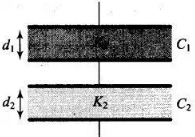
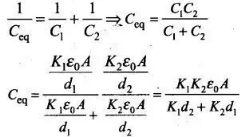 ...(i)
...(i)
We can write the equivalent capacitance as ...(ii)
...(ii)
On comparing (i) and (ii) we have
MULTIPLE CHOICE QUESTIONS - II
Q.7. Consider a uniform electric field in the  direction. The potential is a constant
direction. The potential is a constant
(a) In all space
(b) For any x for a given z
(c) For any y for a given z
(d) On the x-y plane for a given z
Ans. (b, c, d) We know, the electric field intensity E and electric potential V are
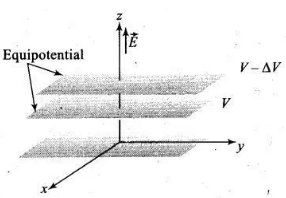 Electric potential decreases inf the direction of electric field. The direction of electric field is always perpendicular to one equipotential surface maintained at high electrostatic potential to other equipotential surface maintained at low electrostatic potential.
Electric potential decreases inf the direction of electric field. The direction of electric field is always perpendicular to one equipotential surface maintained at high electrostatic potential to other equipotential surface maintained at low electrostatic potential.
The electric field in z-direction suggest that equipotential surfaces are in x-y plane. Therefore the potential is a constant for any x for a given z, for any y for a given z and on the x-y plane for a given z.
Q.8. Equipotential surfaces
(a) Are closer in regions of large electric fields compared to regions of lower electric fields.
(b) Will be more crowded near sharp edges of a conductor.
(c) Will be more crowded near regions of large charge densities.
(d) Will always be equally spaced.
Ans. (a, b, c)
Solution.
Key concept: The density of the equipotential lines gives an idea about the magnitude of electric field. Higher the density, larger the field strength.
We know, the electric field intensity E and electric potential V are related as
or we can write
For a given
Hence the electric field intensity E is inversely proportional to the separation between equipotential surfaces. So, equipotential surfaces are closer in regions of large electric fields.)
As electric field intensities is large near sharp edges of charged conductor and near regions of large charge densities. Therefore, equipotential surfaces are closer at such places.
Q.9. The work done to move a charge along an equipotential from A to B
(a) Cannot be defined as 
(b) Must be defined as 
(c) Is zero
(d) Can have a non-zero value
Ans. (c)
Solution.
As the potential on equipotential surface does not change
So (V2-V1)=0
And w = (V2 - V1)= 0
And w=(V2-V1)q.
So, work done on moving a charge is zero, verifies answer (c).
We know the work done by charge q in moving in electric field.
dW = F.dl

 or answer (b) is wrong.
or answer (b) is wrong.
Answer (a) and (b) can be true only when q = +1C which is not given in question.
Q.10. In a region of constant potential
(a) The electric field is uniform
(b) The electric field is zero
(c) There can be no charge inside the region.
(d) The electric field shall necessarily change if a charge is placed outside the region.
Ans. (b, c)
Solution.
We know, the electric field intensity E and electric potential V are dV related as E = - dV/dr
or we can write |E|=ΔV/Δr
The electric field intensity E and electric potential V are related as E = 0 and for V = constant, dV/dr = 0 this imply that electric field intensity E = 0.
If some charge is present inside the region then electric field cannot be zero at that region, for this V = constant is not valid.
Q.11. In the circuit shown in Fig. 2.4. initially key K1 is closed and key K2 is open. Then K1 is opened and K2 is closed (order is important). [Take Q1′ and Q2′ as charges on C1 and C2 and V1 and V2 as voltage respectively.]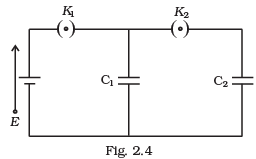 Then
Then
(a) Charge on C1 gets redistributed such that V1 = V2
(b) Charge on C1 gets redistributed such that Q1′ = Q2,′
(c) Charge on C1 gets redistributed such that C1V1 + C2V2 = C1 E
(d) Charge on C1 gets redistributed such that Q1′ + Q2′ = Q
Ans. (a, d)
Solution.
Initially key K1 is closed and key K2 is open, the capacitor C1 is charged by battery and capacitor C2 is still uncharged. Now K1 is opened and K2 is closed, the capacitors C1 and C2 both are connected in parallel. The charge stored by capacitor C1, gets redistributed between C1 and C2 till their potentials become same, i.e., V2 = V1.
By law of conservation of charge, the charge stored in capacitor Cx is equal to sum of charges on capacitors C1 and C2 when K1 is opened and K2 is closed, i.e.,
Q'1+Q'2=Q
Q.12. If a conductor has a potential V ≠ 0 and there are no charges anywhere else outside, then
(a) There must be charges on the surface or inside itself
(b) There cannot be any charge in the body of the conductor
(c) There must be charges only on the surface
(d) There must be charges inside the surface
Ans. (a, b)
Solution.
The potential of a body is due to charge of the body and due to the charge of surrounding. If tfiere are no charges anywhere else outside, then the potential of the body will be due to its own charge. If there is a cavity inside a conducting body, then charge can be placed inside the body. Hence there must be charges on its surface or inside itself. Hence option (a) is correct. The charge resides on the outer surface of a closed charged conductor. Hence there cannot be any charge in the body of the conductor. Hence option (b) is correct.
Q.13. A parallel plate capacitor is connected to a battery as shown in Fig. 2.5. Consider two situations: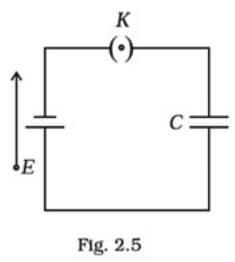 A: Key K is kept closed and plates of capacitors are moved apart using insulating handle.
A: Key K is kept closed and plates of capacitors are moved apart using insulating handle.
B: Key K is opened and plates of capacitors are moved apart using insulating handle.
Choose the correct option(s).
(a) In A : Q remains same but C changes.
(b) In B : V remains same but C changes.
(c) In A : V remains same and hence Q changes.
(d) In B : Q remains same and hence V changes.
Ans. (c, d)
Solution.
The battery maintains the potential difference across connected capacitor in every circumstance. However, charge stored by disconnected charged capacitor remains conserved.
Case A: When key K is kept closed and plates of capacitors are moved apart using insulating handle.
The battery maintains the potential difference across connected capacitor in every circumstance. The separation between two plates increases which in turn decreases its capacitance (C=ϵ0A/d)and potential difference across connected capacitor continue to be the same as capacitor is still connected with battery. Hence, the charge stored decreases as Q = CV.
Case B: When key K is opened and plates of capacitors are moved apart using insulating handle.
The charge stored by isolated charged capacitor remains conserved. The separation between two plates is increasing which in turn decreases its capacitance with the decrease of capacitance, potential difference V increases as V=Q/C.
VERY SHORT ANSWER TYPE QUESTIONS
Q.14. Consider two conducting spheres of radii R1 and R2 with R1 > R2. If the two are at the same potential, the larger sphere has more charge than the smaller sphere. State whether the charge density of the smaller sphere is more or less than that of the larger one.
Ans. Let Q1 and Q2 be the charges on radii R1 and R2 we know that
As V1= V2, So:
⇒ 
⇒ 
⇒ 
⇒ 
⇒ 
Since R1 > R2 it follows that
σ1 > σ2
i.e the charge density of smaller sphere is less than that of larger sphere
Q.15. Do free electrons travel to region of higher potential or lower potential?
Ans. The force on a charge particle in electric field F = qE
The free electrons (negative charge) experience electrostatic force in a direction opposite to the direction of electric field.
The direction of electric field is always from higher potential tolower. Hence direction of travel of electrons is from lower potential to region of higher potential.
Q.16. Can there be a potential difference between two adjacent conductors carrying the same charge?
Ans. Yes, if the sizes are different.
Explanation: We define capacitance of a conductor C = Q/V is the charge of conductor and V is the potential of the conductor. For given charge potential V ∝ 1/C. The capacity of conductor depends on its geometry, so two adjacent conductors carrying the same charge of different dimensions may have different potentials.
Q.17. Can the potential function have a maximum or minimum in free space?Ans. No, the potential function does not have a maximum or minimum in free space, it is because the absence of atmosphere around conductor prevents the phenomenon of electric discharge or potential leakage.
Q.18. A test charge q is made to move in the electric field of a point charge Q along two different closed paths (Fig. 2.6).First path has sections along and perpendicular to lines of electric field. Second path is a rectangular loop of the same area as the first loop. How does the work done compare in the two cases?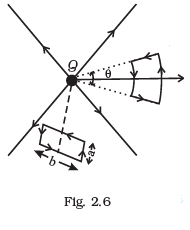 Ans. Work done will be zero in both the cases.
Ans. Work done will be zero in both the cases.
Explanation: The electrostatic field is conservative, and in this field work done by electric force on the charge in a closed loop is zero. In this question both are closed paths, hence the work done in both the cases will be zero.
SHORT ANSWER TYPE QUESTIONS
Q.19. Prove that a closed equipotential surface with no charge within itself must enclose an equipotential volume.
Ans. Let us assume that in a closed equipotential surface with no charge the potential is changing from position to position. Let the potential just inside the surface is different to that of the surface causing in a potential gradient (dV/dr)
It means E ≠ 0 electric field comes into existence, which is given by as E=-dV/dr
It means there will be field lines pointing inwards or outwards from the surface. These lines cannot be again on the surface, as the surface is equipotential. It is possible only when the other end of the field lines are originated from the charges inside. This contradicts the original assumption. Hence, the entire volume inside must be equipotential.
Q.20. A capacitor has some dielectric between its plates, and the capacitor is connected to a DC source. The battery is now disconnected and then the dielectric is removed. State whether the capacitance, the energy stored in it, electric field, charge stored and the voltage will increase, decrease or remain constant.
Ans. The capacitance of the parallel plate capacitor, filled with dielectric medium of dielectric constant K is given by C=K ϵ0A/d
The capacitance of the parallel plate capacitor decreases with the removal of dielectric medium as for air or vacuum K = 1 and for dielectric K > 1.
If we disconnect the battery from capacitor, then the charge stored will remain the same due to conservation of charge.
The energy stored in an isolated charge capacitor U =q2/2C as q is constant, energy stored U ∝ 1/C. As C decreases with the removal of dielectric medium, therefore energy stored increases.
The potential difference across the plates of the capacitor is given by V =q/C
Since q is constant and C decreases which in turn increases V and therefore E increases as E = V/d.
Important point: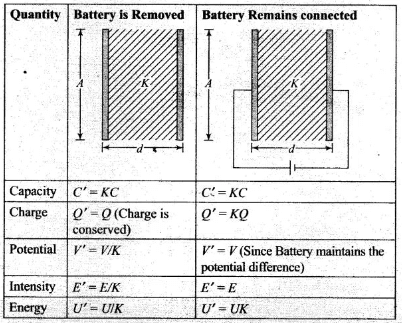
Q.21. Prove that, if an insulated, uncharged conductor is placed near a charged conductor and no other conductors are present, the uncharged body must be intermediate in potential between that of the charged body and that of infinity.
Ans. The electric field E = dV/dr suggests that electric potential decreases along the direction of electric field.
Let us take any path from the eharged’conductor to the uncharged conductor along the direction of electric field. Therefore, the electric potential decrease along this path.
Now, another path from the uncharged conductor to infinity will again continually lower the potential further. This ensures that the uncharged body must be intermediate in potential between that of the charged body and that of infinity.
Q.22. Calculate potential energy of a point charge –q placed along the axis due to a charge +Q uniformly distributed along a ring of radius R. Sketch P.E. as a function of axial distance z from the centre of the ring. Looking at graph, can you see what would happen if -q is displaced slightly from the centre of the ring (along the axis)?
Ans. The potential energy (U) of a point charge q placed at-potential V,U=qV In our case a negative charged particle is placed at the axis of a ring having charge Q. Let the ring has radius a,the electric potential at an axial distance z from the centre of the ring is
Hence potential energy of a point charge -q is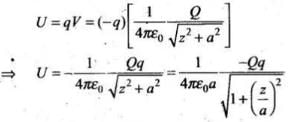

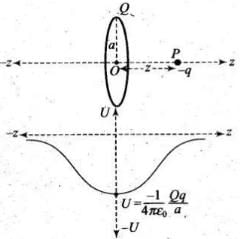
The variation of potential energy with z is shown in the figure.
The charge -q displaced would perform oscillations. Nothing can be concluded just by looking at the graph.
Q.23. Calculate potential on the axis of a ring due to charge Q uniformly distributed along the ring of radius R.
Ans. Let us consider a ring of radius R having charge +Q distributed uniformly. Also a point P at distance z on its axis passing through centre O and perpendicular to plane of ring.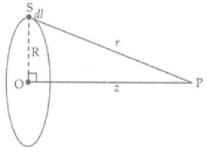
Again consider an element of ring at S of length dl having charge dq and SP is equal to r. Then potential energy due to element to r. Then potential energy due to element dl at P,
Charge on 2 Charge on 2πR length of ring =Q
Charge on dl length of ring =
So potential due to element dl at P,
dV =
Integrating over a ring the potential at P, Vp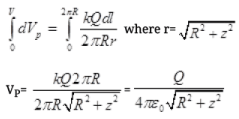
LONG ANSWER TYPE QUESTIONS
Q.24. Find the equation of the equipotentials for an infinite cylinder of radius r0, carrying charge of linear density λ.
Ans. Consider a Gaussian cylindrical dotted surface, S at a distance r from the centre of the cylinder of radius r0 of infinite length.
The electric field lines are radial and perpendicular to the surface. Let electric field intensity on Gaussian surface at P is E, and total charge q on cylinder will be q = λl.
Let electric field intensity on Gaussian surface at P is E, and total charge q on cylinder will be q = λl.
So, by Gauss’s law,
E, 2πrl cos  [∠θ is between Er and curved surface of dotted cylinder is 90°]
[∠θ is between Er and curved surface of dotted cylinder is 90°]
We know that electric field Er at distance r from centre of cylinder 
So potential difference d at distance r0 and r from the centre of cylinder,

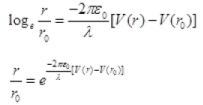

So equipotential surfaces are the coaxial curved surfaces of cylinders with given cylinder of radius r related as above.
Q.25. Two point charges of magnitude + q and - q are placed at (-d/2, 0,0) and (d/2, 0,0), respectively. Find the equation of the equipoential surface where the potential is zero.
Ans. The potential due to charge +q and -q will be zero in between the line joining the two charges +q and -q. Let zero potential is at S.
Then equipotential surface will pass through S and perpendicular to line joining two chargers or AB.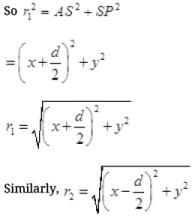
So net potential at P=O


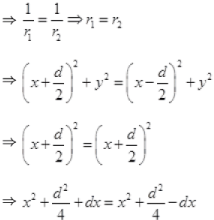
2dx = 0
2d ≠ 0
∴ x = 0
So equipotential surface will be perpendicular to X-axis passing through x=0 i.e., origin in Y-Z plane.
Q.26. A parallel plate capacitor is filled by a dielectric whose relative permittivity varies with the applied voltage (U) as ε = αU where α = 2V-1. A similar capacitor with no dielectric is charged to U0 = 78 V. It is then connected to the uncharged capacitor with the dielectric. Find the final voltage on the capacitors.
Ans. Let C be the capacitance of capacitor C1 without dielectric then charge q1 = CU where U is the final potential of C1 when connected to C2 the capacitor filled with dielectric ε0
C2 = εC
q2 = εCU
= α UCU
= α CU2
Initial charge q0 of C1 when charged at potential of U0 =78 V is,
q0= CU0 =78C
By the law of conservation of charge
q0 = q1 + q2
78C = CU + α .CU2
78 = U + α U2 [α = 2 per volt]
∴ = U+2U2
Or 2U2+U-78=0

 as U is positive
as U is positive Volts
Volts
Final potential on both the capacitors becomes 6 volts.
Q.27. A capacitor is made of two circular plates of radius R each, separated by a distance d<<R. The capacitor is connected to a constant voltage. A thin conducting disc of radius r<<R and thickness t<<r is placed at a centre of the bottom plate. Find the minimum voltage required to lift the disc if the mass of the disc is m.
Ans. Let A and B are circular plates of radius R separated by distance d << R kept horizontally.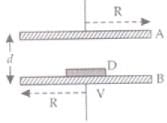
A thin conducting disc D of radius r << R of thickness ‘t’ is placed concentrically on lower plate B as shown in figure.
Let plate A and B charged with potential V.
The magnitude of electric field E between plates of capacitor
Consider Gaussian surface along circular disc D.
By Gauss’s law,

q’ is the charge conducted by plate B to disc D during charging. Nature of charge on plate B and disc will be same so repulsive force acts between B and D.
So, the charge on disc D=q’=
Electrostatic repulsive force acting on disc in upward direction
This repulsive force will be balanced by weight mg of disc D.

Q.28. (a) In a quark model of elementary particles, a neutron is made of one up quarks [charge (2/3) e] and two down quarks [charges –(1/3) e]. Assume that they have a triangle configuration with side length of the order of 10–15 m. Calculate electrostatic potential energy of neutron and compare it with its mass 939 MeV.
(b) Repeat above exercise for a proton which is made of two up and one down quark.
Ans. (a)  [charge on down quark]
[charge on down quark] [charge on up quark]
[charge on up quark]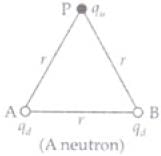
Potential energy 
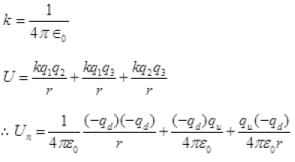
 [Talking sign of charge]
[Talking sign of charge]
[nature sign of charges taken already]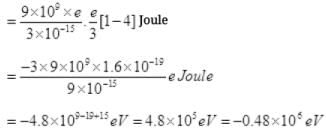
U = -0.48 MeV
So, charges inside neutron [1qu and 2qd] are attracted by energy of 0.48 MeV.
Energy released by a neutron when converted into energy is 939 MeV.
∴ Required ratio  = 0.0005111 = 5.11×10-4
= 0.0005111 = 5.11×10-4
(b) P.E. Of proton consists of 2 up and 1 down quark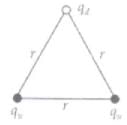
r= 10-15 m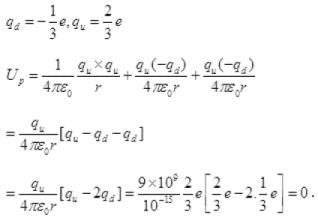
Q.29. Two metal spheres, one of radius R and the other of radius 2R, both have same surface charge density σ. They are brought in contact and separated. What will be new surface charge densities on them?
Ans. Let surface charge density of both the spheres are σ and their charges are q1 and q2.

Both charged spheres are kept in contact, so charge flows between them and their potential becomes equal, let the charges on them now become q1 and q2.
So, V1=V2 
So 
Where q1 and q2 are the charges on spheres after redistribution of charges

By law of conservation of charges
q1+q2 =q1+q2
5q1 = 3q1


Hence,
Q.30. In the circuit shown in Fig. 2.7, initially K1 is closed and K2 is open. What are the charges on each capacitors.
Then K1 was opened and K2 was closed (order is important), What will be the charge on each capacitor now? [C = 1µF]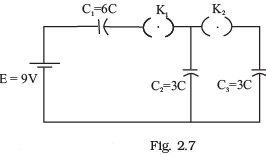 Ans. When K2 is open and K1 is closed the capacitors C1 and C2 will charge and potential develops across them i.e., V1 and V2 respectively which will be equal to the potential of battery 9 V.
Ans. When K2 is open and K1 is closed the capacitors C1 and C2 will charge and potential develops across them i.e., V1 and V2 respectively which will be equal to the potential of battery 9 V.
∴ V1+V2=9......I
∵ 
Or 

3V2=6V1
V2 =2V1.........II
From Eqns. I and II
V1+2 V1 =9
3 V1= 9
V1 = 3 Volt
V2 = 2 x 3 Volt = 6 Volt
∴ q1=C1V1=6C x 3=18C [(from II C = 1qF)
=18 x 1 μF=18 μC
q2=C2V2=3C x 6
=3 x 1 μ F x 6=18 μ C
So, charges on each capacitor i.e., q1=q2=18 μ C
When k1 is open and k2 is closed then charge q2 will be distributed among C2 and C3. Let it be q2 and q3.
∴ q2 = q2 +q3
As C2 and C3 are now in parallel combination so their potentials remain same (V)
∴ q2 C2V+C3V
18 μ C=3 x 1 μ F x V+3 x 1 μ F x V
18=6V
V=3Volt.
So potential on C2 and C3 capacitors are 3 Volt each

Q.31. Calculate potential on the axis of a disc of radius R due to a charge Q uniformly distributed on its surface.
Ans. Consider a point P on the axis perpendicular to the plane of disc and at distance x from the centre O of disc as shown in the figure.
Now consider a ring of radius r of thickness dr on disc of radius R, as shown in figure, Again let the charge on the ring is dq then potential dV due to ring at P, will be
dq is the charge on the ring = σ .area of ring

Because dr is small therefore, dr2 is negligible.

So the potential due to charged disc





Q.32. Two charges q1 and q2 are placed at (0, 0, d) and (0, 0, –d) respectively. Find locus of points where the potential a zero.
Ans. Let the potential at any point P(x,y,z) is zero then -V1+V2=0





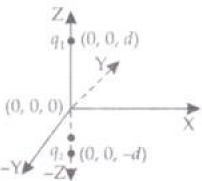
Componendo and dividend
Then componendo and dividend of

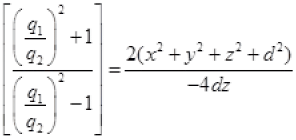
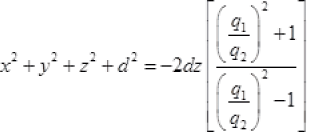
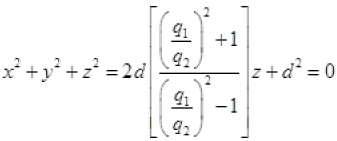

This is the equation of sphere with centre (a,b,c) as required point is on z axis so a=0 , b=0 and z = 2d 

Q.33. Two charges –q each are separated by distance 2d. A third charge + q is kept at mid point O. Find potential energy of + q as a function of small distance x from O due to –q charges. Sketch P.E. v/s x and convince yourself that the charge at O is in an unstable equilibrium.
Ans. 
Let equilibrium of +q is at P at a distance x from mid-point of line joining two charges.
Force FA on +q is towards left side and force FB is towards right side, so for equilibrium of +q at P,
FA=FB
∴ (d-x)2=(d+x)2
d-x = d+x (Taking square root)
-2x=0
x=0
So, Equilibrium position of charge +q between two -q charges is at mid-point (O) of line joining the two charges (-q) and (-q).
Now we have to find out potential energy of +q as a function of small distance x from balance condition (O) towards any of (-q) charge.
Let new position of charge (+q) from a small distance x from (O)



So, U is the P.E. as a function of x.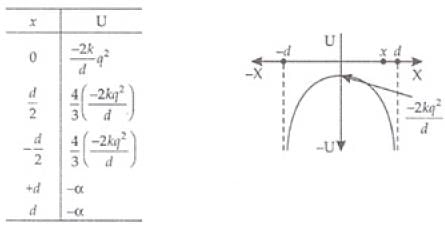
FAQs on NCERT Exemplars: Electrostatic Potential & Capacitance - NCERT Exemplar & Revision Notes for NEET
| 1. What is electrostatic potential? |  |
| 2. How is electrostatic potential different from electric potential energy? |  |
| 3. How is the potential difference related to electric field strength? |  |
| 4. What is a capacitor and how does it store electric charge? |  |
| 5. How is capacitance related to the size and separation of the plates in a capacitor? |  |





















